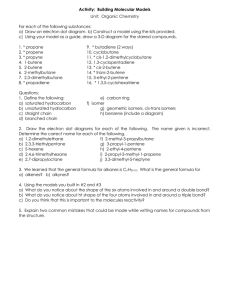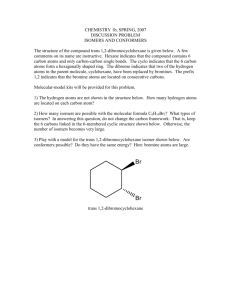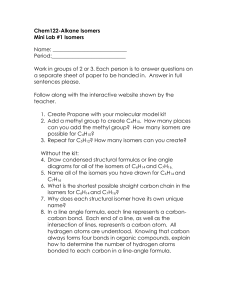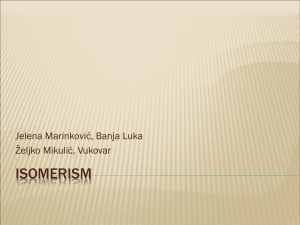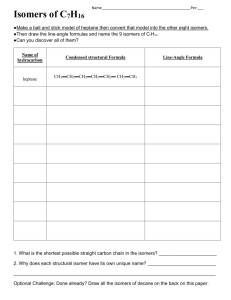Exam 3a - DesignProcessInEducation.com
advertisement
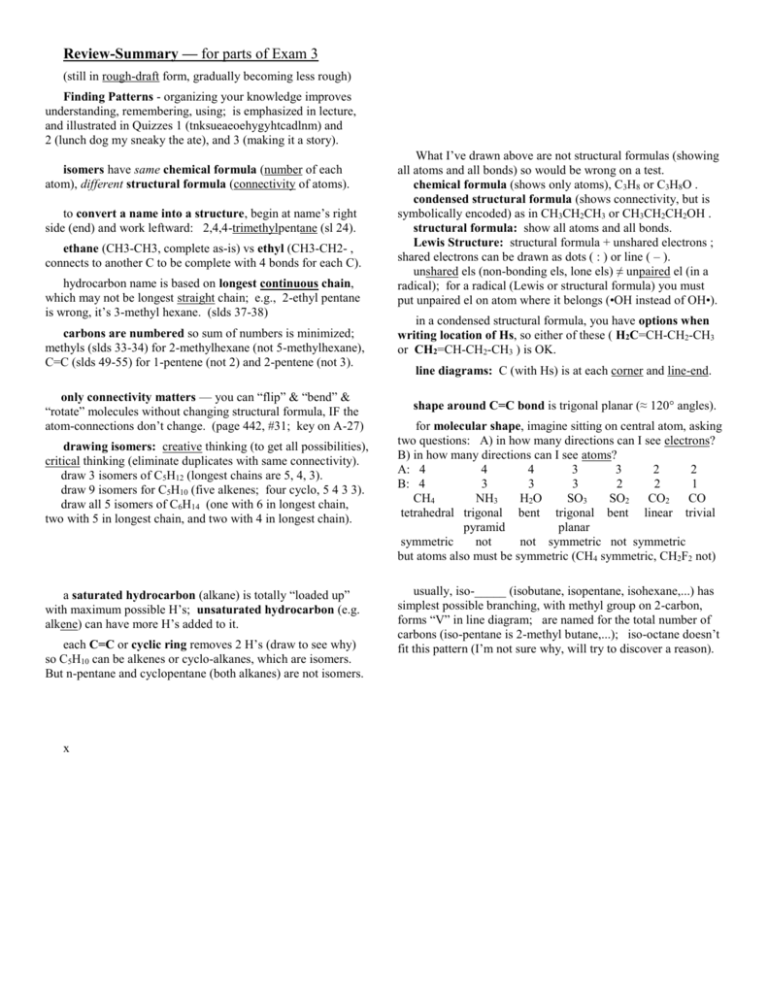
Review-Summary — for parts of Exam 3 (still in rough-draft form, gradually becoming less rough) Finding Patterns - organizing your knowledge improves understanding, remembering, using; is emphasized in lecture, and illustrated in Quizzes 1 (tnksueaeoehygyhtcadlnm) and 2 (lunch dog my sneaky the ate), and 3 (making it a story). isomers have same chemical formula (number of each atom), different structural formula (connectivity of atoms). to convert a name into a structure, begin at name’s right side (end) and work leftward: 2,4,4-trimethylpentane (sl 24). ethane (CH3-CH3, complete as-is) vs ethyl (CH3-CH2- , connects to another C to be complete with 4 bonds for each C). hydrocarbon name is based on longest continuous chain, which may not be longest straight chain; e.g., 2-ethyl pentane is wrong, it’s 3-methyl hexane. (slds 37-38) carbons are numbered so sum of numbers is minimized; methyls (slds 33-34) for 2-methylhexane (not 5-methylhexane), C=C (slds 49-55) for 1-pentene (not 2) and 2-pentene (not 3). only connectivity matters — you can “flip” & “bend” & “rotate” molecules without changing structural formula, IF the atom-connections don’t change. (page 442, #31; key on A-27) drawing isomers: creative thinking (to get all possibilities), critical thinking (eliminate duplicates with same connectivity). draw 3 isomers of C5H12 (longest chains are 5, 4, 3). draw 9 isomers for C5H10 (five alkenes; four cyclo, 5 4 3 3). draw all 5 isomers of C6H14 (one with 6 in longest chain, two with 5 in longest chain, and two with 4 in longest chain). a saturated hydrocarbon (alkane) is totally “loaded up” with maximum possible H’s; unsaturated hydrocarbon (e.g. alkene) can have more H’s added to it. each C=C or cyclic ring removes 2 H’s (draw to see why) so C5H10 can be alkenes or cyclo-alkanes, which are isomers. But n-pentane and cyclopentane (both alkanes) are not isomers. x What I’ve drawn above are not structural formulas (showing all atoms and all bonds) so would be wrong on a test. chemical formula (shows only atoms), C3H8 or C3H8O . condensed structural formula (shows connectivity, but is symbolically encoded) as in CH3CH2CH3 or CH3CH2CH2OH . structural formula: show all atoms and all bonds. Lewis Structure: structural formula + unshared electrons ; shared electrons can be drawn as dots ( : ) or line ( – ). unshared els (non-bonding els, lone els) ≠ unpaired el (in a radical); for a radical (Lewis or structural formula) you must put unpaired el on atom where it belongs (•OH instead of OH•). in a condensed structural formula, you have options when writing location of Hs, so either of these ( H2C=CH-CH2-CH3 or CH2=CH-CH2-CH3 ) is OK. line diagrams: C (with Hs) is at each corner and line-end. shape around C=C bond is trigonal planar (≈ 120° angles). for molecular shape, imagine sitting on central atom, asking two questions: A) in how many directions can I see electrons? B) in how many directions can I see atoms? A: 4 4 4 3 3 2 2 B: 4 3 3 3 2 2 1 CH4 NH3 H2O SO3 SO2 CO2 CO tetrahedral trigonal bent trigonal bent linear trivial pyramid planar symmetric not not symmetric not symmetric but atoms also must be symmetric (CH4 symmetric, CH2F2 not) usually, iso-_____ (isobutane, isopentane, isohexane,...) has simplest possible branching, with methyl group on 2-carbon, forms “V” in line diagram; are named for the total number of carbons (iso-pentane is 2-methyl butane,...); iso-octane doesn’t fit this pattern (I’m not sure why, will try to discover a reason).
